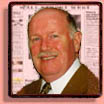
The International Behavioral & Medical Biometrics Society!

JUNE 23, 2009
The 4th IBMBS Conference in October 2009!
On october 16, 17 and 18 the 4th conference of 'The International Behavioral & Medical Biometrics Society' wil take place in Las Vegas, Nevada (USA).
The conference will be presented by chairman Ed Campbell (USA), and the following hand experts are likely to make a presentation: hand analyst Richard Unger (USA), palm reader Deepak Gupta (Australia), cheirologist Kevin Leak (South-Africa), and hand analysts Wang Chenxia (China).
The full program (so far) is available at: www.ibmbs.com (no longer available).
What will be the outcome of conference?
Author: Martijn van Mensvoort
WHAT IS 'BIOMETRICS'? (OR 'BIOMETRY')
The International Biometric Society (not to be confused with Ed Campbell's IBMBS project) provides the following definition of biometrics:
The terms "Biometrics" and "Biometry" have been used since early in the 20th century to refer to the field of development of statistical and mathematical methods applicable to data analysis problems in the biological sciences. Statistical methods for the analysis of data from agricultural field experiments to compare the yields of different varieties of wheat, for the analysis of data from human clinical trials evaluating the relative effectiveness of competing therapies for disease, or for the analysis of data from environmental studies on the effects of air or water pollution on the appearance of human disease in a region or country are all examples of problems that would fall under the umbrella of "Biometrics" as the term has been historically used.
The journal "Biometrics"* is a scholarly publication sponsored by a non-profit professional society (the International Biometric Society) devoted to the dissemination of accounts of the development of such methods and their application in real scientific contexts.
Recently, the term "Biometrics" has also been used to refer to the emerging field of technology devoted to identification of individuals using biological traits, such as those based on retinal or iris scanning, fingerprints, or face recognition. Neither the journal "Biometrics" nor the International Biometric Society is engaged in research, marketing, or reporting related to this technology. Likewise, the editors and staff of the journal are not knowledgeable in this area.
* "Biometrics" is the academic journal of statistics in biology.
by quantitative methods." (R.A. Fisher, 1947)
It is also usefull to notice that biometric characteristics can be divided in two main classes:
• Physiological biometrics: these are related to the shape of the body. Examples include, but are not limited to fingerprint, face recognition, DNA, hand and palm geometry, iris recognition, which has largely replaced retina, and odor/scent.
• Behavioral biometric: these are related to the behavior of a person. Examples include, but are not limited to typing rhythm, gait, and voice. Some researchers have coined the term behaviometrics for this class of biometrics.
Current uses of human biometricsinclude physical characteristics acquired via: fasical scanning, eye scanning (iris/retina), voice scanning, and last but not least: finger scanning + hand scanning (more examples of these are presented below).
WHAT KIND OF 'HAND BIOMETRICS' ARE AVAILABLE?
Jean-Francois Mainguet presents on his website an overview of 20 types of biometrics, including 5 aspects of the hand:
* The additional aspects of hand biometry described by Jean-Francois Mainguet are: handwriting, hand tapping, knuckle creases, hand pressure profile, finger wrinkles, and 3D finger surface.
NEW TYPES OF 'ESOTERIC BIOMETRICS'?
The word 'esoteric biometrics' was introduced by John D. Woodward in his book 'Biometrics' (2002): see below. Woodward described this type as: "biometrics that are still in the early experimental and developmental stages", and his examples are: 'vein pattern', 'facial thermography', 'fingernail bed', 'body odor', 'ear', and 'gait'.
Will the IBMBS movement be able to induce new (diagnostic) developments in the traditional field of biometrics beyond the major biometric themes 'identity' and 'security'?
Likely the answer will depend on the ability of the IBMBS representatives in the field of 'diagnostic biometrics' (e.g. Ed Campbell) to incorporate statistical research & data analyses in the IBMBS-variant of 'diagnostic biometrics'. But the use of data analyses appears not to be a requirement for the presentators of the 2009 IBMBS Conference.
It's unclear whether such developments have already taken place. For example: there is little public information available about the developments reported so far during the IBMBS conferences in 2004, 2005 and 2007.
So far there were no official reports made available to the public after the conferences had taken place.
Hopefully that will be different this year!!?


Related books:
Palmprint Authentication (International Series on Biometrics)
Biometrics: Identity Assurance in the Information Age
Hand analysis & palm reading books

This summer (July 2009) he will participate in a dermatoglyphics panel discussion at the 16th International conference of the Union of Anthropologists and Ethnologists at Yunan University in Kunming, China.
Ed is also working with Dr. Vijayan K. Asari, PhD, Professor in Electrical and Computer Engineering, and graduate students at the Vision Lab, Old Dominion University in Hampton Roads, Virginia, on the development of software for hand analysis and blind testing of statistical accuracy of predictions of behavioral correspondences to hand features.
Related sources:
Fujitsu gives biometrics a Hand
Vein pattern palm reading
Hitachi's Finger VeignID could replace fingerprints
Fingerprints reveal more
PsychoDiagnostic Chirology
Palmistry: a science in process
Palmistry's digital analogue: is 2D:4D finger length measurement the new chiromancy?
Finger length & sexuality: the science of Gaydar
What our fingers can tell us
The 4th IBMBS Conference takes place in October 2009!




